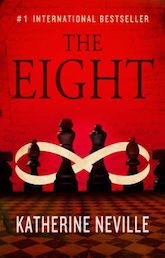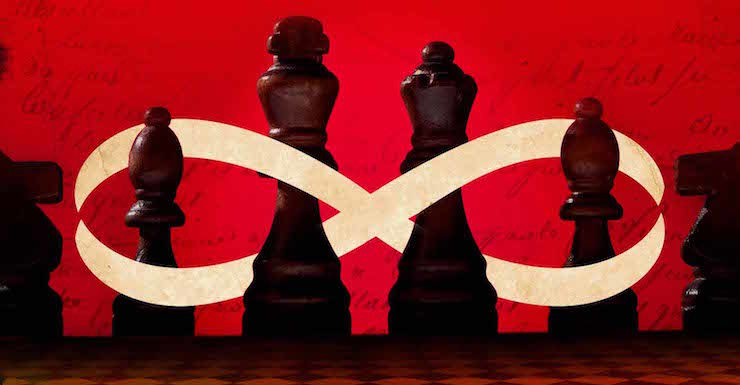I was sitting at my desk at my first agency job, typing submission letters on my IBM Selectric for cook books, diet books, military thrillers, romance novels “written” (not really) by celebrity wives of New York real estate tycoons, wondering if it was too late to apply to med school (yes, I was just out of college, and full of myself), when my friend Helen, who sat at the desk ahead of me, turned around and handed me a book.
It was one of those small paperbacks (mass market, as they call it in the publishing trade), as opposed to the larger format paperbacks reserved for reprints of more upscale works of fiction. The cover featured raised gold foil lettering and a lurid magenta infinity sign hovering over what looked like a carved ivory (yes, I too shudder) chess piece, a knight. I rifled the yellowish, minutely printed pages. There were too many of them, almost six hundred. I had a stack of manuscripts to read for my boss. What was Helen trying to do to me?
“Read it,” she said, her enormous blue eyes checking my reflexive snobbery. “It’ll change your life.”
I was desperate for something to give me hope to carry on through what I knew would be a tedious training process before I could finally represent the sorts of books I liked (this was before I dared to admit to myself that I too wanted to write). I took home The Eight and began to read.
Buy the Book


The Eight
Like Possession by A. S. Byatt, The Eight, first published in 1988, follows two narratives separated by a wide chasm of time. With 32 historical characters and 32 modern, it is structured like a giant chess game.
France, 1790. Mireille and Valentine, two young novices, leave the Montglane Abbey for Paris, each carrying a jeweled chess piece, part of a set that once belonged to Charlemagne. It is the eve of the French Revolution, and the fabled Montglane Service, rumored to possess tremendous powers of destruction, is no longer safe now that the State threatens to take possession of all property belonging to the Church.
New York City, 1972. Catherine Velis, computer expert/accountant, gets ready to leave her office to join some friends for a New Year’s celebration. First, she has to fend off the sexist bullying of one of her bosses, who threatens to send her on assignment to Algiers if she doesn’t oblige his unsavory proposal. She refuses. Later at the party, when one of her friends, an antiques dealer, hears that she’s going to North Africa, he asks her to go on a little buying trip for him. Had she ever heard of the Montglane Service? There’s a dealer in Algiers who has some of the pieces, but he will only negotiate with a woman. Paired with her friend Lily Rad, a chess master who drives around town in a blue convertible Rolls Royce and goes everywhere with her dog, Carioca (a fierce warrior, undaunted by his diminutive size), Catherine flies to Algeria and adventure ensues.
Meanwhile, in France, under the cover of the Revolution, the Great Game begins: who will recover the pieces of the Montglane Service and rule the world? No one, if Mireille can stop them.
Mireille, Valentine, Catherine Velis, Lily Rad—all women my age, all having a lot more fun that I was in my agency cubicle in the pre-word processor, pre-Twitter and Instagram era, fending off my own complement of unsavory advances.
Here is an incomplete list of the interesting people and ideas packed into The Eight: chess, naturally (a game I’ve never been able to learn); secret mathematical formulas; sexy Soviet chess champions (the men are the eye candy in this book, the women are the warriors); Cold War geopolitics; OPEC; Catherine the Great (another strong women who treated men much like a Whitman’s Sampler of Assorted Chocolates); Bach,; Diderot; Voltaire; Rousseau; Robespierre; Napoleon Bonaparte (described very much like Jon Bon Jovi); Blake; Wordsworth; Tallyrand; Marat; Benedict Arnold; Muammar Gaddafi; Freemasonry; mystical cults of the Pyrenees; Fibonacci numbers; magic encoded in mathematical formulas; Alice Through the Looking Glass; Phoenicians; moon goddesses; Alexander the Great; Nimrod; the Tower of Babel; Isaac Newton; the alchemist; quantum physics; Johannes Kepler … in short, this book fits into NO genre.
I could go on. And folks, Katherine Neville makes it work. As I was reading The Eight at night after work, countless people were huddled around their TVs watching Sex and the City, jockeying for possession of Carrie, or Charlotte, because let’s face it, nobody would admit to being a Samantha, and Miranda seemed to always be in a bad mood. I love Sex and the City; I consider Carrie and her Flossy Posse to be feminist icons. Thanks to them, there was a 20-year period during which you’d only find me out of my 4″ heels at the beach or the gym. But even as I plotted the purchase of my next pair, I yearned for something more.
And back in my little sixth floor walk-up on Bleecker and Perry, Katherine was pouring this sort of thing into my mind: “Only in mathematics was there that sense of moving through another dimension, one that didn’t exist in time and place—that feeling of falling into and through a puzzle, of having it surround you in a physical way.”
As I was born in the Soviet Union to a literature-loving doctor and a chess-loving engineer, The Eight spoke to me in several languages.
When I got back to the office the next day I said to my friend, “Okay, you’re right, THIS is a book.” Meaning this is the sort of book I want to write one day.
As I was re-reading The Eight for the purposes of this blog post, I was delighted to discover that all my obsessions were already there: The Gold Mean (i.e. Archimedes’ spiral), Johannes Kepler, soundwaves morphing into particles into matter, God, the Master Mathematician. It was as if Katherine Neville’s ideas had been planted in my mind so many years ago, and only now had they borne fruit in the form of my novella, Mandelbrot the Magnificent.
Mandelbrot may not be Mireille or Catherine Velis, nor does his story have their page count, but he might be their nerdy little nephew.
 Liz Ziemska is a graduate of the Bennington Writing Seminars. Her work has appeared in Tin House, Interfictions: 2, Strange Horizons, Best American Science Fiction and Fantasy, The Pushcart Prize XLI, and has been nominated for a Shirley Jackson Award. She is the author of Mandelbrot the Magnificent and lives in Los Angeles.
Liz Ziemska is a graduate of the Bennington Writing Seminars. Her work has appeared in Tin House, Interfictions: 2, Strange Horizons, Best American Science Fiction and Fantasy, The Pushcart Prize XLI, and has been nominated for a Shirley Jackson Award. She is the author of Mandelbrot the Magnificent and lives in Los Angeles.










